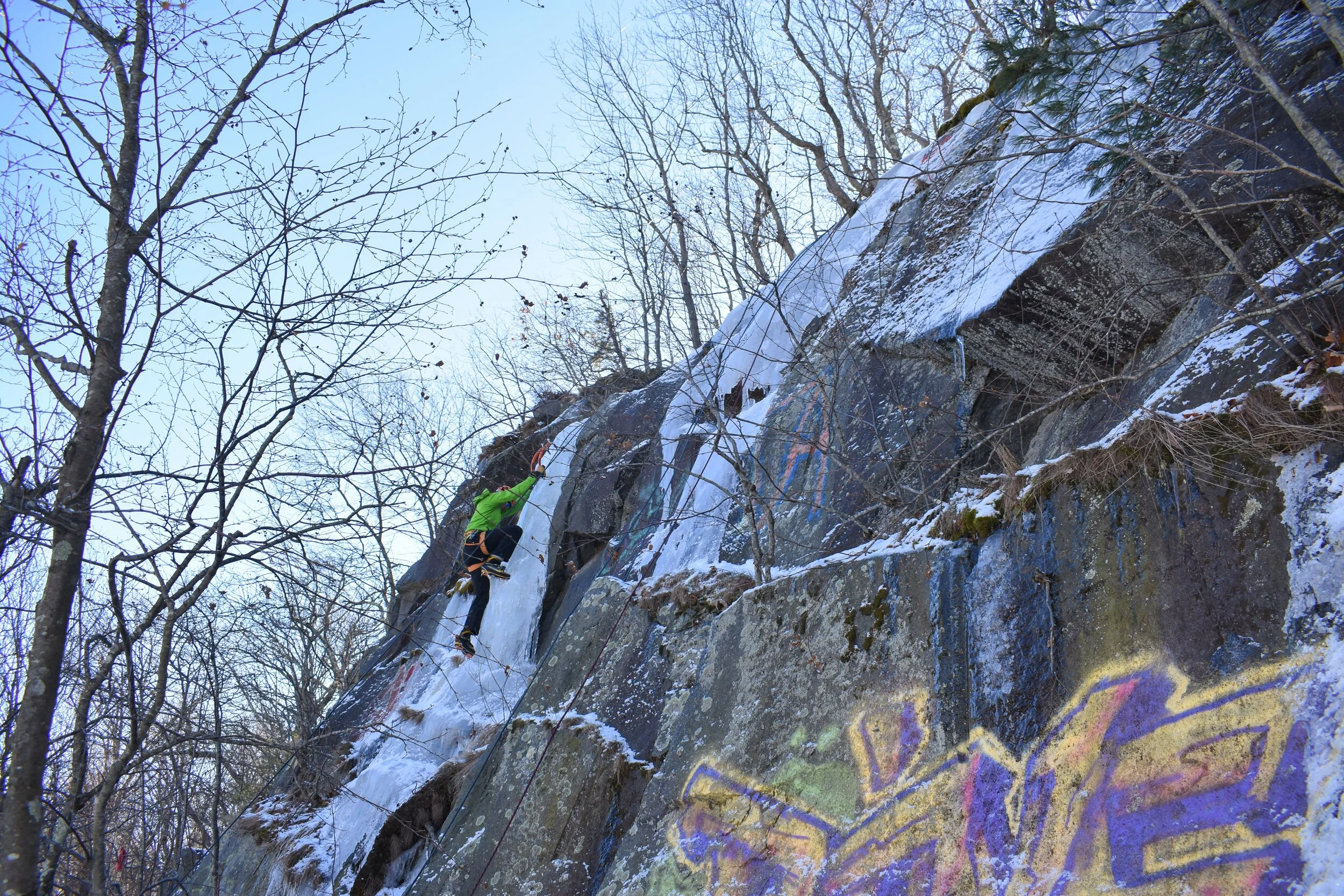Route Profile: Endeavour, White's Ledge
Tim and I recently climbed Endeavour (5.7, Grade III), a classic route up White’s Ledge in Bartlett, New Hampshire, as part of my 2019 Must-Climb Routes. Although unseasonably warm, we were rewarded with engaging climbing, an alpine-like setting, and an incredible view of the White Mountain National Forest as it transitions into its fall splendor. Since the route is south facing and warm, there’s still ample time to jump on it this season.
History
Joe Cote and Roger Martin made the first ascent of Endeavour on November 6, 1971. It’s now a popular outing for climbers looking to escape the crowds at Cathedral and White Horse.
Approach
Take Route 302 to Covered Bridge Lane, then follow this to the Mount Stanton Trailhead. (Covered Bridge Lane is on the east side of the bridge before the Covered Bridge Gift Shop.) The Mt. Stanton lot is a small signed pull-off along Covered Bridge Lane.
From the trailhead, follow the yellow-blazed Mt. Stanton Trail for a short distance (100-150 yards at most), then take a sharp left onto an orange-blazed trail. The path at the junction is a little hard to spot; if you find yourself heading uphill on the Mt. Stanton Trail, you’ve gone way too far.
The next part of the approach is tricky. Follow the orange-blazed trail until you can see the cliff on your right, then bushwhack uphill through the open-ish forest. Eventually, you’ll spot the talus and follow a bunch of cairns to a shady platform at the base of the route.
The key to the approach is not prematurely abandoning the orange-blazed trail. We did (as did the other parties we saw on the cliff that day) and it turned a 30-minute approach into a 45+ minute slog.
Pitches 1 & 2.
Most climbers combine Endeavour’s first two pitches into one lengthy 200-foot mega-pitch. Beginning from the platform, the route starts on a right-facing corner, then zigs and zags its way up a variety of features towards a giant tree just to climbers’ left. A good point of reference for leaders is a clump of maples just to the right of the big tree, as near the top you’ll sneak through a notch just below them to access the large tree anchor.
Although Tim and I both thought getting off the ground was slick, the crux of this mega pitch is near the top. There, climb up and right to a left-facing corner, then climb up towards a small notch by the maple clump. Build your anchor with a cordelette around the big tree.
This mega-pitch has plenty of alternatives for placing protection as well as a few fixed pins. Having many long slings helps keep the rope running straight as you zig-zag your way up.
Pitch 3
From the big tree anchor, clip a pin, then step a few feet right onto a slab. Climb the slabby section, looking for gear (and potentially another pin) on the left as the slab becomes blocky. Ascend up and left into the blocky section, then work back right, aiming for the notch just to the right of the high point of the wall. Approaching the notch, look for protection up high.
To get through the notch (crux), step right, then work your feet up on the bulge. With high feet and one good hand (look for a hand hidden in the crack on your left), work up onto the slab, then beeline for the obvious tree anchor above. Be careful with the loose rock in this section.
The folks on mountainproject.com rated the crux at 5.7+. That felt accurate to us.
To the Top
There’s a couple of ways to the top from the tree anchor atop Pitch 3. The easiest way is to head almost straight up towards the small but obvious tree in a crack to the right of the open slab and about halfway up. With a 70m rope, it’s easy to reach the tree and continue romping up the crack to a two-bolt anchor at the top of the climb. Well-protected and fun!
The straightforward way, however, misses the money pitch—Endeavour’s classic 5.5 hand crack that ascends just left of the arete on the cliff’s right edge. To get there, aim for the same small mid-pitch tree, but just below it make a hard right towards the cliff’s right side. Find the crack then jam up it as far as your rope will take you. Depending on the length of your rope you might have to split the pitch in two, building an anchor somewhere in the middle of the crack. From there, blast up to the trees.
Whichever route you use to get to the tree ledge, there’s still a bit more climbing to the top of the cliff. First, continue up some blocky low-fifth class terrain for another pitch (35-40 meters) until you come to a bushy gully. Then ascend the gully, weaving your way through third and occasionally fourth class terrain towards the top of the cliff.
Descent
For the descent, follow the yellow blazes of the Mt. Stanton Trail to climber’s right. This briefly traverses the top of the cliff, then descends back down towards the parking area. The descent is about 1.5 miles and takes 30-40 minutes.
Some folks also rap the route, but it didn’t look that fun, particularly because the climb diagonals right, meaning each rap will diagonal left. Additionally, there’s currently only one ring and bolt at the rap anchor atop Pitch 2.
The Rack
A regular rack with doubles in finger and hand sizes worked great for us. Having a bunch of slings (10) really helps keep the rope running straight on the first pitch.






